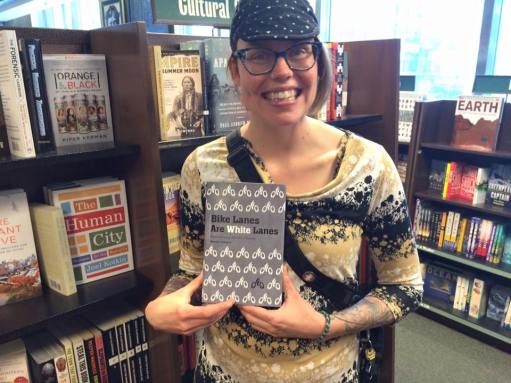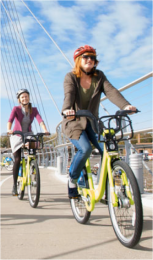Big news! The Minneapolis Bicycle Coalition is hosting my book release party on Sept. 12 in Minneapolis. If you live in the area, please RSVP to attend the event. People of color and WTF (women, trans, femme) will be given seating priority.
NOTE: due to the overwhelming response, there will be an overflow room and a livestream which I will post on social media for all my non-Minneapolis followers.
I wrote this blog post to frame the event but also to illustrate how my thinking has shifted since I wrote this book (the publishing cycle is quite long).
.png?1472762714)
.png?1472762714)
The following blog post was originally published on the Minneapolis Bicycle Coalition website.
Before bike lanes were white lanes, there was biking while Black.
The majority of people who bicycle are people of color. So why does it seem like our bicycle infrastructure is dominated by white people? In some instances, it was designed to be that way.
Cities like Minneapolis have realized the economic advantages in highlighting local bicycle amenities in its marketing to upwardly mobile white people. And so, when bicycle advocates approach a city with bicycle lane plans, those that want to recruit talented, young (white) people are much more likely to approve such infrastructure. Despite bicycle advocacy’s history rooted in direct action like Critical Mass, there has been a notable increase in advocates working directly (and politely) with cities (including the Minneapolis Bicycle Coalition).
It’s all about the benjamins
It is a good thing that cities are taking bicycling seriously as a mode of transportation. The problem is that the economic development focus is guiding both cities and advocates away from a vision of bicycling for everybody. What is the benefit of adding in bicycle lanes in North Minneapolis or the West Bank (two areas of Minneapolis with a high percentage of lower income, people of color) if the desirable “creative class” won’t be there to fill the lanes?
To be clear, the actions of bicycle advocates and city officials who prioritize privileged bicyclists in their communities may not be intentional. For example, a major road in a upcoming white neighborhood gets repaved, and a bicycle organization lobbies for new bicycle lanes during the repaving process. Did they think through whether that neighborhood already had “enough” bicycle infrastructure? Maybe, maybe not. What matters is that people outside of the privileged advocacy circles have understood these actions as exclusive, unfair, or downright racist.
Ok, but what about the communities with predominantly people of color,who do get bicycle infrastructure, only for it to fill with cobwebs or becomes infiltrated with white men in spandex?
I would offer up two explanations:
-
Bicycle infrastructure in the U.S. has largely become a signifier of the white, middle-class. If all you see is white, hipster commuters in the bicycle lanes there is a silent signal being sent that that space is not for you. Just as, for example, white women don’t typically frequent Somali cafes filled with Somali men around Minneapolis.
-
People of color, especially immigrants and African Americans, are constantly threatened in public space.

Some elaboration on the second point.
We are currently grappling with some horrific, racialized police violence leading to the deaths of numerous young black people and a lack of indictments for these police officers.
What strikes me is how many of these young people died after being harassed on the streets, getting off a train, or riding in a car. The unnecessary killings of people like Philando Castile, Michael Brown, Rekia Boyd, and Freddie Gray (to name just a few) make clear that within the post racial America myth, it is a life-threatening move for black people to be outside, often in their own neighborhoods. Brown specifically drew attention to himself by walking in the street instead of on the sidewalk. Tamir Rice was shot and killed in a public park. Eric Garner was standing outside a local business. Being black in a public space runs the risk of harassment and profiling by the police.
When faced with these racialized lived experiences, baseless arrests, and death sentences, all for being a mobile person of color, it is hard to argue that bicycling can be one step toward community safety.
I am not arguing that bicycle advocates should just give up on engaging a more diverse group of bicyclists. Mainstream bicycle advocates have societal power and privilege to exploit it for equity purposes. Bicycle advocates who lobby for their projects should keep the safety concerns of people of color in the front of their minds. Bicycle advocates have successfully normalized cycling in many U.S. cities, and their national platform is a powerful space to problematize the profiling of young people of color on bicycles.
How is the Minneapolis Bicycle Coalition addressing this issue?
From my standpoint as a volunteer with the Minneapolis Bicycle Coalition I can speak to two major initiatives, although there are many more examples that could be discussed.
-
A people-of-color-only transportation committee. Why only people of color? Well, as much as we white folks love to help with racial justice work, sometimes a space needs to be created for the actual people at stake to have the complete floor for planning and action. After all, who knows better what a community needs than one’s own community?
-
Racial justice research projects including a soon-to-be-released report on police citations and related arrests. I will be speaking more about this research project at the book release party on Sept. 12. (and furthermore on this blog!)

Author of Bike Lanes are White Lanes (me) at Barnes and Noble downtown Minneapolis. Photo by Robb Hoffmann


.png?1472762714)

